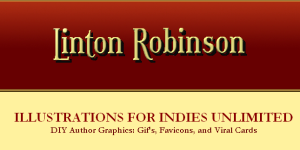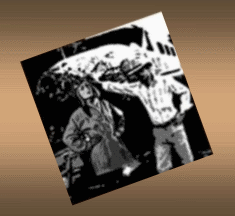 This is the final section of this tutorial to deal with “mini-graphics”–small images for various writerly purposes–before discussing topics more related to generating covers and other major graphic output. There are three applications I think many writers would find useful–and all three are also a lot of fun for more general applications such as entertaining kids (inner and outer varieties) or just clowning and attracting eyeballs to your brand.
This is the final section of this tutorial to deal with “mini-graphics”–small images for various writerly purposes–before discussing topics more related to generating covers and other major graphic output. There are three applications I think many writers would find useful–and all three are also a lot of fun for more general applications such as entertaining kids (inner and outer varieties) or just clowning and attracting eyeballs to your brand.
I don’t go into great detail on creating these—most information is available on the sites of the programs—but if anybody is interested in creating them and wants to discuss it, contact me.
For various reasons most of the examples of these images are not displayed here, but in a little gallery on another site. Even if you aren’t interested in learning to do these types of images yourself, I’d invite you to take a look.
http://linrobinson.com/graphics/graphics4.php
Animated .gif Images
I promised previously to discuss making animated .gif images, so I will. Anigifs, as I will call them here, are the little moving images you see on the web: mini-animation that can be employed for a lot of purposes, from eye-grabbing covers on book sites to the creation of ingenious cartoons and stunning fine art. I have some outstanding examples of many genres on the site linked to above. I sometimes use them to promote full lines of books, as you see in the gif of my covers on this any my own page. I use that animation a lot: it takes up the space of one image, but shows a lot of covers, rather than just one.
You see them used for writer pics or logos sometimes, as well. And increasingly, you’re seeing animated covers. This just makes the whole “grab their attention” aspect of a cover more impactive and with more possibilities. Animated covers are seen more often on auxiliary marketing sites like Goodreads than on main stores like B&N or Amazon. This could work really well with a “featured book” or interview.
I’ve collected a few on that page to show some of the possibilities people have been working.
Anigifs, by the way, are a legitimate art form in their own right. I have two galleries on that page: one a collection of “mini-movie” gifs, the other a list of sites featuring “cinemagraphs”, a kind of “high art” application of the motion capacities of gif files.
And the thing is, they aren’t that hard to make. It can be time-consuming, especially at first, but it’s neither high tech, nor artsy-intensive. There are many programs and sites to build gif animation, but I’d suggest you start out with the simple, but comprehensive, Beneton program linked to from that page.
There’s not too much to it… an animated gif is composed of a series of gif images of the same size. Small is good since the finished file can only load as fast as ALL of the component images. They can be unrelated images, like my book covers, or a progressive series like the “cels” used to produce film animation. These two examples create the progression by use of features in the Paint.net graphics program. The IU spinner is done with the Zoom/Rotate feature in the “Layers” menu. Just as easy to do a zoom-in with that standard app—a technique used in many animated covers. The “TwirLin” abomination uses “cels” progressively twisted with the Effects plug-in called “Twist”. “Progressively Twisted” is also my business model. To show a stack of book covers, favorite authors, or collections of your own author shots, all you have to do is alter all the images to the same dimension of .gif files.
Once a series of images is created, you load them into the Beneton program and can select how much delay between them (i.e. how fast the “movie” will run) and whether the animation will repeat indefinitely, or just run once and stop. The final file produced will be a .gif “movie”, and can be treated as any other image.
[If you need a step-by-step tutorial, check out Carolyn Steele’s post here.]
Icons and Favicons
![]() A “favicon” is about as specialized as graphics for writers get, a tiny detail that does little but make you look a little more professional, like a regimental tie tack or Phi Beta key. But it does set a website apart a little, and is easy enough to accomplish. IF you have your own website/domain: won’t work on Blogger accounts or other public sites. You’ve probably noticed while web-surfing that most pro and corporate sites have a little tiny graphic beside their name on the browser line listing. And most browsers show that little icon when you bookmark them. So when you look through your bookmarks, certain sites have little “billboards” rather than just their name. You can easily have one to make you own website stand out. I show several of them on the page linked to up top, but you can see them on any of my own sites. The quickest one to spot is the little IU logo at the top of this page.
A “favicon” is about as specialized as graphics for writers get, a tiny detail that does little but make you look a little more professional, like a regimental tie tack or Phi Beta key. But it does set a website apart a little, and is easy enough to accomplish. IF you have your own website/domain: won’t work on Blogger accounts or other public sites. You’ve probably noticed while web-surfing that most pro and corporate sites have a little tiny graphic beside their name on the browser line listing. And most browsers show that little icon when you bookmark them. So when you look through your bookmarks, certain sites have little “billboards” rather than just their name. You can easily have one to make you own website stand out. I show several of them on the page linked to up top, but you can see them on any of my own sites. The quickest one to spot is the little IU logo at the top of this page.
There are several free programs and online sites to create them from 16×16 pixel graphics: I recommend the free Adsen Favicon Maker, linked to on the reference page. You can create a favicon from scratch, or more easily, convert one you’ve already made elsewhere. You shrink down photos and see how they look (have to be pretty simple to show anything at that size.) You can create a 16×16 button on CoolText.com. You can just make a square that size with a border, then type in your initials and load it into Adsen for conversion into a favicon–which is more than an image: it contains all sorts of positioning information as well as the pixel elements.
Once you have your favicon—which will always be named “favicon.ico”, you upload it to the main directory of your website and invoke it by placing the following tag in the <head></head> section of your webpages.
<link rel=”shortcut icon” href=”favicon.ico”>
This should invoke the favicon and give you a brand logo whenever your website is seen.
There are also fun, time-wasting uses for this program. You can create icons for your computer! Yes, customize your directory listings or add cool images to the program shortcuts on your desktop. Kids love this stuff, but it can be useful to have your important directories jump out at you when you are working. Done the same way, but you can make bigger ones–32×32, or whatever size the icons that come with your computer establish.
Social Media “Cards”
 A third application I want to discuss here isn’t a special production type, but rather an innovative application that recently occurred to me, and which could be useful to you in the ongoing chore of cozening eyeballs to your own bailiwicks and buy buttons.
A third application I want to discuss here isn’t a special production type, but rather an innovative application that recently occurred to me, and which could be useful to you in the ongoing chore of cozening eyeballs to your own bailiwicks and buy buttons.
You’ve all seen–and perhaps collected, shared or tweeted–funny or inspirational “cards” on Facebook or Twitter or other social media sites. Take a look at the “Cards” link on the gallery site link at the top of this page to see what I mean: you’ve seen a lot of these. There are companies that post them. They are “linkbait”–a very effective way of spreading mention of your feeds and timelines. They are the visual equivalent of jokes: you pick up on them and pass them around, nobody cares where they came from. They are, essentially, viral stunts.
But what if the cards you flashed had your own logo or URL on them instead of some eye candy site? There’s no great technique involved here, just clever application. Create a horizontal colored “card” in your graphics program and paste in your own Victorian clipart, cartoon, of silly picture, type in your cute comments in the blank space… and place your own information in the corner. Child’s play. This is one application where you can get away with swiping about anything: famous images, ads, photos of the famous and shameless–anything to set off your punchline or (de)motivational message.
Place them somewhere to link to them. Your own blog, uploads to Facebook, your website folders, or whatever. The more you can “attach” to them like homing beacons, the better. If you put them on your WordPress blog, be sure to give them self-serving titles and tags: not “Garfield typing” but “Writing Humor From Joe Author at http://joeauthor.com”. Then link to that image in order to flash your fans and viewers on whatever media you find sociable.
Nothing says you have to stick to the same sort of “stock” cards everybody else does–you’re the artist now and can dream up your own applications. How about “baseball cards” of your characters? Pithy quotes from your book with the title and “on amazon.com” below it? How about questions or riddles that link to the answer when clicked? For something “everybody’s doing”, this is a promo technique that remains wide open for anybody who wants to press the envelope.




The favicon looks pretty interesting. I’d seen the little logos next to site names, but never knew how people got them. Thanks for the tip.